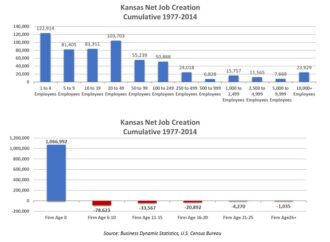To state the obvious, the Kansas state government blew the chance for a 2020 V-shaped economic recovery. Despite evidence small business activity leads to a strong economy, state officials seem determined to undermine this engine of economic opportunity. Now, new data reveals the state’s anti-small business sentiment caused small business openings to re-plummet and extend the COVID recession.
The graphic below highlights the number of Kansas small businesses relative to January levels. While small businesses aren’t necessarily startups, the change in small businesses speaks to startup activity. The percent change in the number of small businesses operating fell from the Year-To-Date high in mid-March to -6.9% by the time the lockdown ended, to -12.2% by early August, the most recent data available. It’s possible school closures contributed to the decline in small business activity as some Kansans chose to stay home and supervise their child’s instruction. Kansas small business activity rebounded as firms received federal relief payments such as Paycheck Protection Program or the Economic Injury Disaster Loans.
Lastly, even though the KS lockdown ended, small business activity stagnated. Lockdowns don’t just destroy jobs and a potential labor base, but they can also do long-term damage to “capital structure”. These are investments machinery, plants, equipment, and even land that makes for a faster economic rebound. Gross fixed capital formation in the U.S. fell 8.1% in the second quarter of 2020 compared to the average quarterly 4.6% drop throughout the entire “Great Recession.” Additionally, the lack of action by the state government to promote jobs, savings, and investment prolongs the time it takes for Kansas to return to a prosperous economy.
 The relationship between entrepreneurship and growth isn’t just crucial in 2020 but has been important for decades, and will be important for decades to come. In the two adjacent charts spanning 4 decades, it’s evident. Nothing predicts strong job growth and overall economic growth than the performance of small firms and startups*. The top graph visualizes that most jobs come from firms with fewer than 50 employees. The bottom chart looks at job growth by the age of the business. Effectively, there is no job growth if not for startups.
The relationship between entrepreneurship and growth isn’t just crucial in 2020 but has been important for decades, and will be important for decades to come. In the two adjacent charts spanning 4 decades, it’s evident. Nothing predicts strong job growth and overall economic growth than the performance of small firms and startups*. The top graph visualizes that most jobs come from firms with fewer than 50 employees. The bottom chart looks at job growth by the age of the business. Effectively, there is no job growth if not for startups.
Dr. Hall of the Brandmeyer Center for Applied Economics from the University of Kansas explains the mechanics between small business activity and faster economic growth. Dr. Hall notes that Kansas needs more dynamism or business “churn”. It’s a trial and error process of business start-ups and failures until entrepreneurs find an under-served market. This continuous progress is known as creative destruction, coined by political economist Joseph Schumpeter.
STAR Bonds and corporate handouts failed before the COVID pandemic, and signs say they will fail again. Commissioned by the Kansas Policy Institute, Dr. Art Hall examined the job effects of two STAR Bonds in Wichita, the Riverwalk STAR Bond, and the K-96/Greenwich STAR Bond. By analyzing job trends within the STAR Bond areas and near it, Dr. Hall discovered STAR Bonds don’t create new jobs. Instead, the data reveals it cannibalizes job growth that almost-certainly would’ve happened in nearby zip codes.
To paraphrase the KC Royals from their championship season, “Keep the line moving”. Ned Yost couldn’t predict a big hit but understood keeping the line-up moving gave a better chance to score runs. Similarly, Kansas economic development officials have little idea which business will take off. Yet, often act in futility providing handouts and subsidies. They need to create a dynamic economic environment in which lots of businesses get up to bat with a chance to get a big hit, employing Kansans and massively improving prosperity in the state. With signs the Kansas economic downturn will continue into next year, business dynamism is our only hope.
*See pages 13-15 for a Dr. Hall’s full discussion on job creation dynamics
Wichita Incentive-Economic Perspectives - KPI Paper





